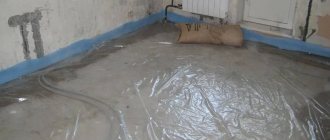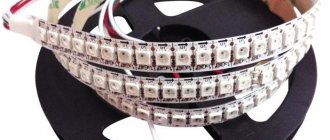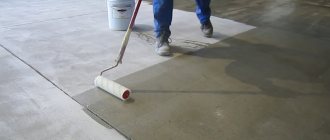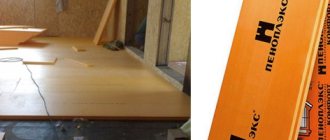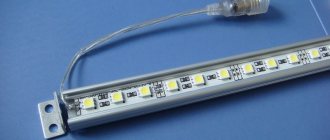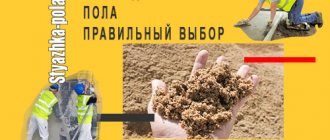For what purpose and where is it used?
This is a relatively new material, which is consumable and consists of tapes of different thicknesses and heights, made of elastic materials that easily compress under load and restore their shape in its absence. The raw material for production is foamed polyethylene, in closed cells of which there is air.
To understand how the tape works, you can do a simple experiment. If you squeeze it with your fingers, the air bubbles are flattened, the material becomes thinner, but returns to its original size when the pressure is released.
After which it becomes clear why the damper tape is needed. Its main function in the structure of a concrete floor is to compensate for the linear expansion of the screed, preventing its deformation in case of hard contact with the walls. As the slab expands, it presses not on the wall, but on an elastic gasket installed between them and filling the gap between the contacting planes.
Shock-absorbing tape when installing a floating screed Source i2.wp.com
However, the use of such a layer makes sense only if the screed is floating, that is, not connected to the base and mounted on waterproofing (waterproof film) or thermal insulation (insulation boards). If it is laid on a stable base and does not have a heating system, the damper will be useless.
But there are other tasks that can be achieved using this material. When deciding whether a damper tape is needed for a floor screed, you should also remember these:
- Compensation for periodic expansion of heated screeds from a heated floor system.
When the system is running, the plate expands in proportion to the heating force, and when it is turned off, it contracts. Periodically occurring pressure on the walls can ruin the external finish and cause stress and deformation in the structure itself.
On a note! When installing heated floors along external walls, it is better to install strips of insulation. This will not only compensate for temperature changes, but also reduce heat loss.
Diagram of a heated water floor Source pol-inform.ru
- Creating a gap between rooms with different thermal circuits.
In adjacent rooms, different temperatures of the heated floor are often set. Accordingly, it is necessary to arrange a thermal gap between them.
Such a compensator is mounted in a doorway Source eurosantehnik.ru
- Reduced vibration noise.
Another important point why damper tape is needed when screeding is to improve sound insulation between rooms. It dampens vibration and impact noise and prevents its transmission through supporting structures. This is especially true in high-rise buildings, townhouses and country houses with several apartments.
On a note! There is a special type of damper tapes - vibration damping tapes. They are made from rubber, caoutchouc, and other materials and are glued to metal profiles, which are the basis of the frame for interior partitions and wall cladding.
- Reduced cracking when fresh screed matures.
During the drying process, concrete loses moisture and “breaks” with the appearance of cracks. This problem is solved by reinforcing the screed and isolating it from the walls with an elastic gasket. It is laid around the perimeter, as well as in the body of the screed, if its linear dimensions on any side exceed 6-8 meters or the total area of the screed is more than 20 sq.m.
Separating the screed with a compression tape reduces the formation of shrinkage cracks Source chudopol.ru
- Construction of a technological gap between screed sectors poured at time intervals.
When a fresh screed comes into direct contact with a previously poured screed that has already gained strength, uncontrolled stresses arise that affect the strength of the coating. They are compensated by laying a buffer layer between adjacent sectors.
Summarizing the above, such a gasket must be done in the case of a floating screed or heated concrete screed. If we answer the question whether a damper tape is needed when pouring a self-leveling floor, then it will be positive only if there is a thick layer of leveling mixture or when it is installed on top of a heated floor. Simple thin-layer coatings up to 10 mm high do not need an edge around the perimeter of the walls.
When installing thin-layer self-leveling coatings, a buffer layer is not needed Source i.ytimg.com
All other cases are considered individually, the choice remains at the discretion of the home owner.
What are damper tapes?
Kinds
The material is distinguished according to several characteristics:
- According to the structure of polyethylene – cross-linked and non-cross-linked.
Sewn material is more expensive, but of better quality - it is more elastic and reliable. When uncrosslinked, the cell walls tear under heavy load.
- Depending on the installation location, the tape can be edge or intercircuit.
Edge screeds are mounted along the edges of the screed to be poured along the walls and have a flat or L-shaped shape. Intercircuit tapes are designed for making expansion joints in large-area screeds and between adjacent heating circuits. They are shaped like an inverted T, making it easy to secure the strips to the base without side support.
- According to the installation method.
The simplest type of tape is ordinary flat strips, which are simply pressed against the walls with mortar or pre-attached with improvised means. Strips with adhesive applied to the reverse side simplify the task of attaching the damper tape to the wall. The sticky layer of self-adhesive is protected by paper, which can be easily removed before installation.
Installation of tape with adhesive strip Source pol-exp.com
Both standard and self-adhesive strips can have a “skirt” - this is an outlet made of non-foamed polyethylene on one side. During installation, the tape with the “skirt” straightened out on the floor takes the shape of an inverted letter G. The resulting angle prevents the solution from leaking into the junction of the floor and walls, which increases the functionality of the buffer.
- By the presence of cuts.
Such products are often provided with small cuts along the entire length at several levels. They make it easier to remove excess material protruding above the surface of the finished coating.
The cuts allow you to tear off excess at the desired height Source pol-exp.com
What is a damper tape?
It is made from foamed polyethylene. Its positive performance qualities are that it does not rot or mold. Does not deform under sunlight or any other ultraviolet radiation. The tape is easy to install because one of its sides is adhesive, which greatly facilitates the installation process. The tape is simply glued along the perimeter of the walls at their base, where the layer of self-leveling floor will come into contact with it.
The tape is produced in skeins from 10 to 20 meters long. Thickness no more than 8 mm. And the standard height is 150 mm. Along its entire length, the tape is divided into self-separating strips 8-10 mm wide. This is convenient, since after installation the excess part of the tape protruding above the floor must be removed. The strips are needed so as not to cut off the part protruding above the floor surface with a knife, which does not always work out beautifully. Simply tear off the remaining strips of tape above the floor surface.
Video description
What can happen if you do not leave gaps along the walls when laying laminate, watch in the video:
The excess part of the strip protruding above the plane of the final coating is cut to its level or left behind the baseboard.
The thickness of the buffer layer is selected in accordance with the linear dimensions of the screed. When installing it in standard residential premises and garages, shock absorbers with a thickness of 6-10 mm are usually used.
The material is sold in rolls of various lengths from 10 to 150 meters. You can easily calculate the length you need by adding up the perimeter of all the walls and the length of the expansion joints in rooms with screed.
To get a rough idea of the price order, check out this table:
Parameters of damper tapes from different manufacturers Source i.ibb.co
Installation features
The developer may have a question about how to attach the damper tape and when to do it. Installation is carried out before pouring the screed, but after installing the waterproofing. As a rule, film and any other waterproofing on the sides is lifted and placed on the walls, in which case the buffer tape is installed on top of it.
The installation method depends on the type of product. If it has an adhesive layer, everything is simple: place the roll with the sticky side to the wall and, gradually unrolling it and removing the protective layer, glue the strip to the base, slightly pulling it so as not to falsify. If there is a film release (“skirt”), it is spread on the floor, folded at the corners into a triangle.
Installation of L-shaped tape Source o-builder.ru
Having finished gluing one roll, the second is mounted overlapping, starting the beginning of the second strip 5 cm from the end of the first.
If there is no adhesive strip, you first need to determine the front and back sides. The reverse side is usually smoother and shiny, and it is pressed against the wall.
Rigid fastening is not necessary - the strip can simply be pressed with the solution during its installation. But this is very inconvenient: you have to constantly make sure that it does not fall or bend under the screed, otherwise the whole point of why the damper tape is needed is lost.
Therefore, choose one of the most convenient fixation methods:
- shoot with a stapler, the staples of which easily fit into the wooden base;
- drill the dowel with nails;
- glued with double-sided tape, liquid nails or other adhesive.
Installation technology
- The damper tape for the screed is laid along the perimeter of the room until the cement-sand base is installed. If there are architectural elements such as partitions or columns, then it is also carried out around them. The compensator is laid continuously, without breaks. If necessary, the edges of the strips are overlapped.
- First, you need to clean the room from dust and anything that would prevent the adhesive layer from being securely fixed to the surface.
Advice
Sometimes loose fitting of expansion strips is due to defects in the material itself. To avoid this, the base on which it is laid must be thoroughly dried and degreased. The material should be stored only in dry rooms at room temperature.
- After laying it, you should go over it with a roller. This will increase the reliability of gluing, since small defects are smoothed out and the strip is pressed more tightly to the wall.
- The product is supplied in rolls. This is very convenient, since you can gradually unwind the roll and in the process remove the protective layer and attach the compensator to the wall.
- According to SNiP, the permissible maximum screed area is 10 square meters. m. When constructing large surfaces, it is divided into sectors. Products of this type are also used to compensate for the resulting seams.
- The width of the compensator is selected depending on the height of the screed. The tape is installed just above the level of pouring the cement-sand mixture by about 1.5–2 cm. When it sets, the excess part of the material is either cut off or torn off along the factory cuts.
- Please note that it cannot be removed completely. In the case of ceramic tile covering, it is removed only after grouting the joints. This allows you to get a significantly better result.
- Fastening should begin from the corner of the room. The cutting angle must be even. During installation, there is no need to stretch the strip - its thickness should be uniform around the entire perimeter.
- If there is no adhesive backing, you can secure the tape using liquid nails or double-sided tape. The latter option is preferable, as it will provide tight pressure.
If, after installing the decorative covering, you are going to install a plinth, then the protruding part of the compensator does not need to be cut off, since it will cover it.
The method of fastening directly depends on the type of tape: it is recommended to attach the regular one to liquid nails, self-adhesive and with a skirt to the existing adhesive layer. In the latter case, it is necessary to ensure that the skirt is completely hidden under the screed layer.
The damper tape for heated floors is laid after the waterproofing has been installed. It is placed either under the vapor barrier or between the heating elements of the underfloor heating system and the vapor barrier layer.
What materials can be replaced
Having figured out what a damper tape is and what it is needed for, many developers are thinking about replacing it with other materials with similar characteristics and saving money. This solution seems especially attractive if, after building a house, there is a lot of unused insulation, laminate underlay, linoleum scraps, etc. left.
In principle, such a replacement is possible, but it will not be complete:
- Foam plastic, after compression under load, is not able to fully restore its shape, as a result of which a gap remains between the vertical surface and the screed.
- Linoleum is generally not a sufficiently elastic material.
- Laminate backing, isolon and penofol, like the original buffer tape, are made from polyethylene foam. But they usually have a lower density and do not have good soundproofing properties.
Penofol and isolon are an affordable analogue of damper tape Source opt-299062.ssl.1c-bitrix-cdn.ru
- Wooden slats, which were previously widely used to make expansion joints, are also poor shock absorbers, and they are also susceptible to destruction from moisture, mold and other external influences.
To get a strip of the required width, it needs to be cut from the roll. This can be done in a variety of ways. The longest way to cut is with scissors. It is much faster and more accurate to cut with a sharp stationery knife on a flat and hard surface, made along a guide. To do this, roll out the roll on the floor or on a board, place a guide rail at a selected distance from the edge and guide it with the tip of a knife along it.
To speed up the process, the material can be folded in several layers.
If you need to cut strips of great length (and for a medium-sized house they may require several hundred meters), it is better to roll the material into a tight roll and cut it with a hacksaw according to the markings.
Types of damper tape material
The raw materials from which the tape is made are foil insulation or polyethylene (foam). They have a coating that makes it possible to firmly seal the seams of the repaired coating.
Foamed polyethylene
For practicality, the material has a self-adhesive strip, which speeds up installation. The top layer of strips is equipped with cuts, which makes it convenient for removing excess tape after finishing work. The tape protects the main floor material from the ingress of liquids, since a plastic film (apron) is glued to it. The factory strip is quite expensive, so you can replace it with foil insulation.
Folgoizol
The product is made from the same material (foamed polyethylene), but the material has a fine structure. Therefore, to obtain the required thickness of the edge tape, you will have to apply 3 layers of this material. Installation on a wooden surface is carried out using screws, since the product does not have an adhesive coating. If the fastening is carried out to a brick or concrete surface, then plastic dowels are stuffed, and then the tape is attached. Place washers under the screws, which you make yourself from plastic bottles.
Sometimes, instead of these materials, isover and polypropylene are used - they are cut into identical strips and glued in the required places with glue.
Briefly about the main thing
Now you know what a damper tape for floor screed is, what it is needed for, what it is made from and what functions it performs. Its main purpose is to compensate for the movements of a floating concrete screed or self-leveling floor, and to serve as a shock absorber between them and adjacent surfaces. The material is sold in the form of rolls of different thicknesses and widths, fixed along the bottom of the walls or separates screed sectors with different heating circuits. Mounted using an adhesive layer or mechanical fasteners. You can replace the tape with similar materials cut into strips - isolon, penofol, laminate backing.
Ratings 0
